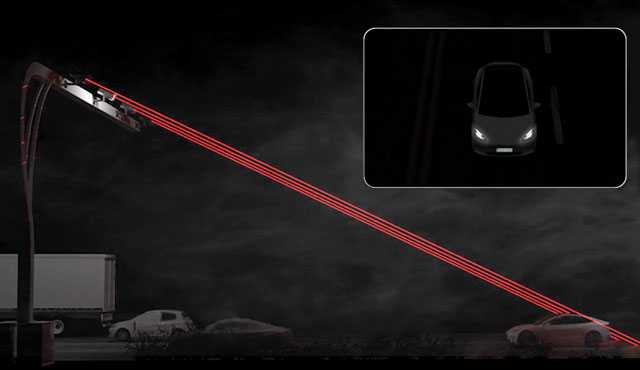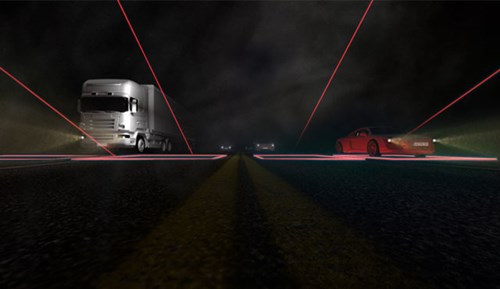Adaptive Recognition: How Vidar’s Built-in Laser Trigger Provides Exceptional ANPR

Vidar, Adaptive Recognition’s ANPR camera, comes with built-in laser triggering. Our expert explains why laser triggering provides exceptional results and why it is still the most reliable way of capturing license plates.
In the world of vehicle detection and automatic number plate recognition (ANPR), the golden rule is simple: you blink, you lose. Accurate triggering makes or breaks your ANPR project. Too many missed vehicles, and you miss out on income, false-positive readings can lead to complications, and extra manual checks to ensure accuracy costs time and money.
Therefore, avoiding these mistakes via the accurate triggering of ANPR cameras is the most crucial part of adequately operating a traffic monitoring system. Recently, however, ANPR camera manufacturers have started to provide software-based triggering options in their products. These virtual triggers are quite innovative and require fewer moving parts in the plate recognition camera. But if that’s the case and software-based license plate capturing solutions are the future, why are we talking about laser triggering?
Why Laser Is Still the Best Trigger
Undoubtedly, one of the biggest advantages of laser triggering is that it’s entirely hardware-based. Why does it count? Imagine a pitch-dark night that reduces the visibility range to just a few meters. With no appropriate (light) conditions, plate recognition cameras relying on virtual triggers start missing approaching vehicles and, therefore, cannot execute ANPR functions accurately. And even a 1% drop in detection rate can have severe consequences.
No automatic detection means manual data entry that could easily lead to an avalanche of mistakes. For instance, considering 5,000 vehicles per day, that 1% drop means 50 undetected cars. What if one of those missed cars didn’t pay the road toll? Without the appropriate photo to prove the violation of the law, authorities cannot send the cheque to the vehicle’s owner. If the fine is 50 USD, and just five cars out of the undetected 50 didn’t pay the toll, that still means an annual loss of more than $90,000 USD – the price of two police cars with smart traffic monitoring cameras. Let’s raise the stakes further. What if the missed vehicle participated in child abduction, and finding it is the number one priority?
However, the laser is virtually infallible. When it detects a car, it immediately sends a signal to the camera to snap the picture and start the ANPR process. The technology is as simple as it gets. Let’s take spot laser, the most commonly used triggering method, as an example. All you need is a transmitter to emit the laser beam and a receiver to catch it as it bounces back from the ground at the speed of light. With these, you have enough data at your disposal to calculate the time and distance the laser beam needs to reach the road’s surface. If the beam returns to the laser sensors faster than the preset time, it means that it has been obstructed by something, and the camera is triggered to take the necessary action.
Distance calculation also comes in handy during the setup of number plate reading cameras, especially overhead models intended to be used on gantries. With laser technology, installers can determine if the camera looks in the correct direction or needs further tilting to focus on the traffic below. Simply put, if the camera is correctly set up, it’s guaranteed that it will never miss anything.
Spot Laser Vs. Laser Curtain
Although spot laser can be a blessing in vehicle detection, there is no denying that it has a weakness: it’s just a tiny dot on the road. If a vehicle veers off the center of the lane, it may be missed by the laser beam, and the triggering will not occur. Adjusting the camera, even if it’s done remotely without major time loss, still causes some downtime and extra costs that installers simply cannot afford – especially when time and accurate capturing are of the essence.
Theoretically, this problem could be avoided by installing a laser curtain. In this case, the beam would be reflected back and forth between multiple mirrors, creating an invisible but penetrable wall that guarantees the desired 24/7 triggering no matter what. However, there is a catch: the mirrors. It’s one thing that the mirrors need to be adjusted, even replaced from time to time. For traffic monitoring cameras that have to withstand extreme conditions for a long time without maintenance, moving parts like those tiny mirrors have the potential of malfunctioning. Even specks of dirt can be an issue, preventing the laser beam from bouncing back and forth between the mirrors. Unfortunately, rain cannot clean the mirrors, so road maintenance groups have no choice but to visit the gantry with the laser curtain. And closing lanes just for that is a nightmare for everyone: traffic is blocked for many hours, while road operators have to pay a lot for the road works.
In other words, a spot laser may miss a few vehicles, but it contains no moving parts and can be easily calibrated to deliver the desired ANPR results. Not to mention that, unlike laser curtains that need to be installed separately, spot lasers can be easily integrated into the ANPR camera itself.

With Your Powers Combined, I Am Captain Vidar!
As simple as laser triggering is, the main problem is that it often requires two separate devices: a spot laser and an ANPR camera. It’s not rocket science to figure out that maintaining two devices costs more money and time. And seeing how few components a spot laser consists of, integrating one into the other seemed like an obvious next step. This idea correlated with the philosophy of Adaptive Recognition, as we constantly strive for being the best in providing the most reliable and economical solutions in the ANPR and traffic camera market. The result is Vidar, the first traffic monitoring camera in the industry with built-in laser triggering.
Named after the silent god from Norse mythology, Vidar is indeed a silent guardian of the roads with immense power and the eyes of an eagle. Aside from being equipped with two fully customizable software-based triggers, namely the virtual loop and Plate Finder, top-tier Vidar models offer the much-desired laser technology built into the camera itself. With the laser sensors onboard, traffic monitoring system operators never need to bother setting up two different machines if they wish to enjoy both powerful ANPR and laser triggering. Thanks to Vidar’s two separate CPUs, one processor operates general functions and hardware such as the laser sensors. At the same time, the other performs ANPR-related processes only. The result is faster response time and, most importantly, increased reliability.
With Vidar’s laser triggering, capturing vehicles is a breeze. But with the other two software-based triggers, it’s even better. Learn how.
About Adaptive Recognition
_logo.jpg) Adaptive Recognition is a group of creative minds, developing and manufacturing AI-based image processing technology, for the traffic, security, and identity industries.
Adaptive Recognition is a group of creative minds, developing and manufacturing AI-based image processing technology, for the traffic, security, and identity industries.
Adaptive Recognition's first major successes came with our globally market-leading Carmen® ANPR (Automatic Number Plate Recognition) product, which is capable of automatically recognizing and reading images of car license plates. This was followed by introducing various standardized codes, which are used, among other things, in shipping or printed on ID documents like passports.
The small startup transformed into a professional international company with locations in Denmark, the USA, Asia-Pacific, Central-Europe, and Singapore, with 300+ employees and 30+ representative partners worldwide.






Comments
There are no comments yet for this item
Join the discussion